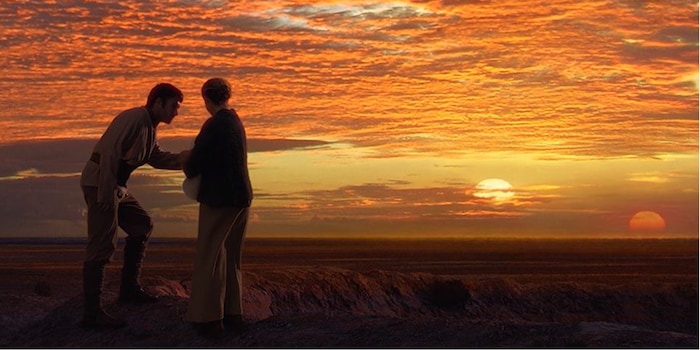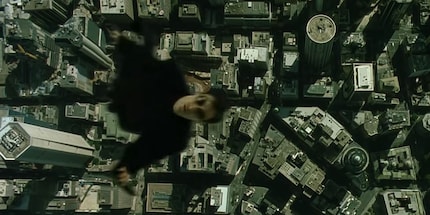
Background information
«House of the Dragon»: what does the new intro mean?
by Luca Fontana

"Star Wars Episode III" is better than "Lord of the Rings" in the end. Fact. Time to take a look at the last few minutes of a film - the end.
"I don't know the future. But I will show people what you don't want them to see - a world without you."
Neo hangs up the phone. He looks up at the sky. Then he flies out of the picture in Superman style. Fade to black. "Rage Against the Machine" booms out of the speakers. The credits roll. An audience of millions wants to see part two - now.

The perfect film ending is not a product of chance; it can be constructed. And in such a way that the audience craves more.
In the following paragraphs, there will be spoilers for:
An ending that is too long challenges your patience. What comes up is ending fatigue. The lack of suspense makes it almost impossible to maintain interest long after the main plot has been resolved.
"Lord of the Rings: The Return of the King" is a film with ending fatigue. In order to save Middle-earth, Frodo (Elijah Wood) must destroy the Ring of Power by throwing it into the lava of Mount Doom. This happens after around three hours and 34 minutes in the director's cut. This is followed by 15 minutes in which the most important subplots are resolved:
The perfect ending. Actually. Instead, the film starts again. Frodo has an incurable injury and has to leave Middle-earth because of it. He sets off for a place that is supposed to be the elvish version of heaven. By ship. Before that, he says goodbye to his friends at the harbour. The whole thing takes about 15 minutes. An eternity. Then there's another scene in which Sam returns home. Finally the credits roll, about 27 minutes and 50 seconds after Frodo has thrown the ring into the lava.
It shouldn't take more than ten minutes from the resolution of the main plot to the end credits. The story must be structured in such a way that the audience senses when the end is near. This is not the case at the end of the Ring saga. "Too many endings, man", acting legend Jack Nicholson is said to have once said to Frodo actor Elijah Wood as he left the cinema early. He should know.
The conclusion to the Harry Potter series does it better. Lord Voldemort (Ralph Fiennes) is defeated by Harry Potter (Daniel Radcliffe) in a duel after an hour and 50 minutes. This is followed by a scene at King's Cross Station in London. Set 19 years later. Harry, his friends, their children - all is well. The credits roll 8 minutes and 10 seconds after Voldemort bites the dust.
An unexpected ending is not a must, but it is an effective technique to keep the audience engaged with the film beyond leaving the cinema. This can be done in two ways:
According to Henry Boseley - who runs a film blog on YouTube, The Closer Look - "The Usual Suspects" has one of the most intelligent moments in Hollywood cinema.
In a police interrogation, Roger "Verbal" Kint (Kevin Spacey) describes the course of a bomb attack that left 27 people dead. He himself maintains his innocence. His motor disabilities rule him out as a suspect. The chief inspector believes him. Verbal is released. As he limps along the pavement towards freedom, but then walks more normally with every step he takes, it becomes clear that Verbal is not disabled at all. He has fooled everyone. Even the audience. In truth, he is the perpetrator.
Roger "Verbal" Kint: "The greatest trick the devil has ever pulled is to make the world believe that he doesn't exist. And just like that... he's gone."
It is similarly effective to end the film with a question to which the audience has to find an answer. For example, whether Dominick Cobb (Leonardo DiCaprio) has finally found his happy ending in "Inception" or is still dreaming. Or what Hannibal Lecter (Anthony Hopkins), serial killer and cannibal, means in "The Silence of the Lambs" when he wants to meet an old friend for dinner seconds before the end credits roll.
Films have more than one plot. Most of the time. The problem lies in ending them at the right time. The emotional impact on the audience is greater when several storylines end at the same time.
Back to "Lord of the Rings: The Return of the King". There, director and screenwriter Peter Jackson ends all the storylines one after the other.
All this happens in just under half an hour. The unnecessary slow-motion sequences make it even longer
.
There's a better way. For example, in "Star Wars: The Revenge of the Sith", written by George Lucas. Also the conclusion of a trilogy. There are essentially three plots there:
The end: Anakin's death is also the birth of Darth Vader. At the same time, Padme dies, having just given birth to twins Luke and Leia. Then the construction of the ultimate weapon of evil begins - the Death Star. It symbolises the fall of the Republic and the rise of the Empire.
All this happens within four minutes and 55 seconds.
The audience realises: we are at the end of the story. The emotional impact of each individual plot resolution is great because Lucas ends them simultaneously - not one after the other and stretched out over half an hour.

In the red light of Tatooine's double sunset, Luke Skywalker's foster parents look forward to a better future; a new hope.
I write about technology as if it were cinema, and about films as if they were real life. Between bits and blockbusters, I’m after stories that move people, not just generate clicks. And yes – sometimes I listen to film scores louder than I probably should.
Interesting facts about products, behind-the-scenes looks at manufacturers and deep-dives on interesting people.
Show all